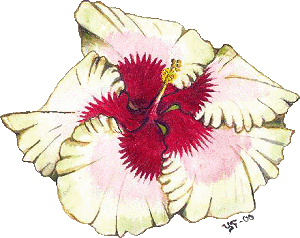Now and then you will hear hibiscus growers recommend fish emulsion as fertilizer when growing hibiscus. Often it is recommended together with Epsom salt as additives to your regular fertilizer. Often we are told that the Native American population would use fish fertilizer for their corn crop so obviously fish refuse is not just a flash in the pan. And, says some, it is all organic. Before you all rush out to buy fish cleanings, stop and think for a moment.
I don't want to start a "fish" war here but if you use a high end fertilizer with minor elements (minors) there is no need to add extras such as fish emulsion (for calcium and certain minors) or Epsom salt (magnesium) unless your plant food doesn't contain it. (I here assume you're using it as a soil additive as labeled and not a foliar spray.) Check the analysis printed on all fertilizer bags to confirm it contains magnesium. Plus, adding excess calcium may well be the reason that you need to add the magnesium as well, as high calcium levels inhibit the plant's ability to take up magnesium. Most of the water used in the US and elsewhere has sufficient calcium for plants already in it, which is why we usually do not supplement with it.
Another problem with fish emulsion is that it contains proteins, something plants can't use, which must be broken down by microbes in the soil into a for plants suitable form. During the breakdown process, the microbes absorb oxygen that should have been available to your plants' root systems, in a worst case scenario suffocating the roots. Protein after breaking down yields for plants usable nitrogen but that is already available in your basic fertilizer. Fish emulsion is also high in phosphorus and low in potassium, thus if you use a 10-10-10 formula and add fish emulsion you can inadvertently create a 12-15-10.5 (based on Bonide fish emulsion data) formula instead and that was hardly your intention! Note that fish emulsion boosts the phosphorous to unacceptably high levels (fish are rich in phosphors) and as we know hibiscus aren't keen on high amounts of phosphorous.
In addition, as fish are sea living creatures, a typical fish emulsion contains chlorine, something hibiscus DON'T need on a regular basis! In fact, chlorine can cause salt buildup in your soil, which will also inhibit plant growth. Higher concentrations of soluble salts often result in chlorosis, defoliation, stem dieback, leaf burn, or inhibition of growth. Nothing of which we want to see on our plants I'm sure!
Commercial fertilizers are diligently tested, contain only substances that are suitable for plants and have a declared value for all available nutrients. The trick here is to choose a plant food that suits the needs of the plant species you're growing, as there's no shortage of fertilizer formulas on the market. For hibiscus look for a formula that has a low middle (P) number and where the potassium outstrips the nitrogen. Make certain it contains minors, preferably in chelated form as it's easier for the plants to absorb, and I can assure you your plants will thrive without fish emulsion or Epsom salt!
If you want to do something organic to benefit your plants why not add worm casts (castings) or fully composted humus to the pots or ground around them? Or use one of the many sea weed or kelp products instead of fish emulsion as they contain all that you want from using marine products but without the drawbacks. All these will renew the beneficial microorganisms that colonize the roots and assist plants in many ways.
Personally I've now grown hibiscus for over 30 years and never in all those years have I had to resort to using fish emulsion or Epsom salt. However, I have always used a good fertilizer with minors. Only now and then have I given extra iron since hibiscus are heavy users of iron but that's the only extras I've had to give them. So be careful when combining commercial fertilizers with homemade "improvements" -you may end up doing more harm than good.
Seriously, isn't it time to bury the fish emulsion where it can't do any harm - in the compost pile? These boiled together fish leftovers are nothing but fish glue, very similar to other animal glues and just as nutritious, read not at all. What the Native Americans used wasn't this rubbish but whole fresh fish, well, uncooked anyway, flesh and all. During the decomposing process they would break down and release nitrogen, potassium and phosphor into the soil, pretty much like modern fertilizers. So if anyone wants to go the natural way it's not fish emulsion you need but fresh fish! Whether it's better than simply using regular fertilizer I cannot say but one thing is clear: You'd be mighty popular with the neighborhood cats!



